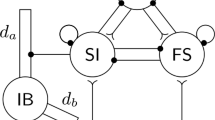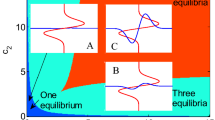Abstract
The dynamic behavior of a model of two electrically coupled oscillatory neurons was studied while the external polarizing current was varied. It was found that the system with weak coupling can demonstrate one of five stable oscillatory modes: (1) in-phase oscillations with zero phase shift; (2) antiphase oscillations with halfperiod phase shift; (3) oscillations with any fixed phase shift depending on the value of the external polarizing current; (4) both in-phase and antiphase oscillations for the same current value, where the oscillation type depends on the initial conditions; (5) both in-phase and quasiperiodic oscillations for the same current value. All of these modes were robust, and they persisted despite small variations of the oscillator parameters. We assume that similar regimes, for example antiphase oscillations, can be detected in neurophysiological experiments. Possible applications to central pattern generator models are discussed.
Similar content being viewed by others
References
Aronson DG, Ermentrout GB, Kopell N (1990) Amplitude response of coupled oscillators. Physica D 41:403–449
Arshavsky Yul, Belozerova IN, Orlovsky GN, Panchin YuV, Pavlova GA (1985) Control of locomotion in marine mollusk Clione limacina. III. On the origin of locomotory rhythm. Exp Brain Res 58:263–272
Blehman II (1981) Sychronization in nature and engineering (in Russian). Nauka, Moscow
Borisyuk GN, Borisyuk RM, Khibnik AI (1992) Analysis of oscillatory regimes of a coupled neural oscillator system with application to visual cortex modeling. In: Taylor JG, Caianiello RM, Cotterill RMJ (eds) Neural network dynamics. Springer, Berlin Heidelberg New York, pp 208–225
Cazalets JR, Nagy F, Moulins M (1990) Suppressive control of the crustacean pyloric network by a pair of identified interneurons. I. Modulation of the motor pattern. J Neurosci 10:448–457
Collins JJ, Stewart IN (1993) Coupled nonlinear oscillators and the symmetries of animal gaits. J Nonlin Sci 3:349–392
Constantine-Paton M, Cline HT, Debski E (1990) Patterned activity, synaptic convergence, and the NMDA receptor in developing visual pathways. Annu Rev Neurosci 13:129–154
Cruse H (1990) What mechanisms coordinate leg movement in walking arthropods? Trends Neurosci 13:15–21
Dermietzel R, Spray D (1993) Gap junction in the brain: where, what type, how many and why? TINS 16:186–192
Dongarra JJ, Bunch JR, Moler CB, Stewart GW (1978) LINPACK users guide. SIAM Publications, Philadelphia
Eisen JS, Marder E (1984) A mechanism for production of phase shifts in a pattern generator. J Neurophysiol 51:1375–1393
Ermentrout GB, Kopell N (1991) Multiple pulse interactions and averaging in systems of coupled neural oscillators. J Math Biol 29:195–217
Fenichel N (1971) Persistence and smoothness of invariant manifolds for flows. Indiana Univ Mathematics J 21:3
Getting PA (1988) Comparative analysis of invertebrate central pattern generators. In: Cohen AH, Rossignol S, Grillner S (eds) Neural control of rhythmic movements in vertebrates. Wiley, New York, pp 101–127
Grillner S, Matsushima T (1991) The neural network underlying locomotion in lamprey — synaptic and cellular mechanisms. Neuron 7:1–15
Harris-Warrick RM (1988) Chemical modulation of central pattern generators. In: Cohen AH, Rossignol S, Grillner S (eds) Neural control of rhythmic movements in vertebrates. Wiley, New York, pp 286–331
Hartmann F (1964) Ordinary differential equations. Wiley, New York
Hindmarsh JL, Rose RM (1982) A model of the nerve impulse using two first-order differential equations. Nature 296:162–164
Hindmarsh JL, Rose RM (1984) A model of neuronal bursting using three coupled first order differential equations. Proc R Soc Lond B 221:87–102
Kawato M, Sokabe M, Suzuki R (1979) Synergism and antagonism of neurons caused by an electrical synapse. Biol Cybern 34:81–89
Khibnik AI, Borisyuk RM, Roose D (1992) Numerical bifurcation analysis of a model of coupled neural oscillators. Int Ser Num Math 104:215–228
Khibnik AI, Kuznetsov YuA, Levitin VV, Nikolaev EV (1993) Continuation techniques and interactive software for bifurcation analysis of ODEs and iterated maps. In: Proceedings of Advanced NATO Workshop on Homoclinic Chaos. Physica D V. 62 (sn1–4):360–367
Kopell N (1988) Toward a theory of modelling central pattern generators. In: Cohen AH, Rossignol S, Grillner S (eds) Neural control of rhythmic movements in vertebrates. Wiley, New York, pp 369–413
Malkin IG (1956) Some problems of the theory of nonlinear oscillations (in Russian). Gostehizdat, Moscow
Marder E, Eisen JS (1984) Electrically coupled pacemaker neurons respond differently to same physiological inputs and neurotransmitters. J Neurophysiol 51:1362–1374
Marder E. Hooper SL, Eisen JS (1987) Multiple neurotransmitters provide a mechanism for the production of multiple outputs from a single neuronal circuit. In: Edelman GM, Gall WE, Cowan MW (eds) Synaptic function, NRF. Wiley, New York, pp 305–327
Marder E, Abbot LF, Kepler T, Hooper SL (1992) Modification of oscillator function by electrical coupling to nonoscillatory neurons. In: Basar E, Bullock TH (eds) Induced rhythms in the brain. Birkhauser, Boston, pp 287–296
Müller U, Cruse H (1991) The contralateral coordination of walking legs in the crayfish Astacus leptodactylus. II. Model calculations. Biol Cybern 64:437–446
Rand RH, Cohen AH, Holmes PJ (1988) Systems of coupled oscillators as models of central pattern generators. In: Cohen AH, Rossignol S, Grillner S (eds) Neural control of rhythmic movements in vertebrates. Wiley, New York, pp 333–367
Schöner G, Jiang WY, Kelso JAS (1990) A synergetic theory of quadrupedal gaits and gait transitions. J Theor Biol 142:359–391
Selverston AI, Moulins M (1985) Oscillatory neural networks. Annu Rev Physiol 47:29–48
Taga G, Yamaguchi Y, Shimizu H (1991) Self-organized control of bipedal locomotion by neural oscillators in unpredictable environment. Biol Cybern 65:147–159
Yang XD, Korn H, Faber DS (1990) Long-term potentiation of electrotonic coupling at mixed synapses. Nature 348:542–545
Yuste R, Peinado A, Katz LC (1992) Neuronal domains in developing neocortex. Science 257:665–668
Author information
Authors and Affiliations
Rights and permissions
About this article
Cite this article
Cymbalyuk, G.S., Nikolaev, E.V. & Borisyuk, R.M. In-phase and antiphase self-oscillations in a model of two electrically coupled pacemakers. Biol. Cybern. 71, 153–160 (1994). https://doi.org/10.1007/BF00197318
Received:
Accepted:
Issue Date:
DOI: https://doi.org/10.1007/BF00197318




